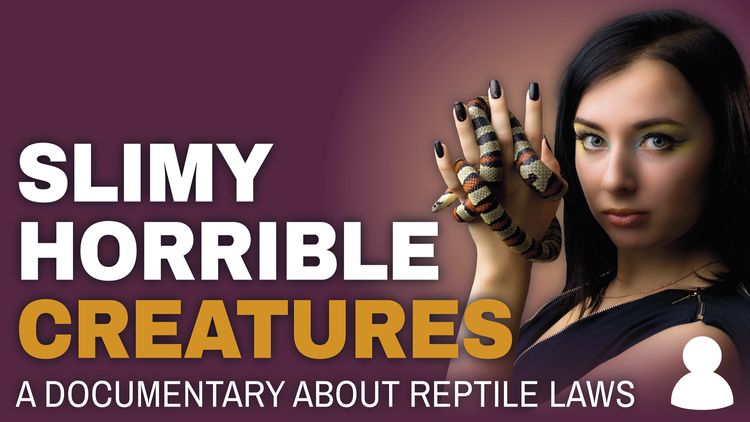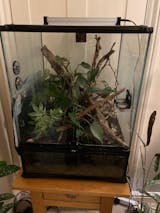About
Our Leopard Gecko care sheet has all the expert guidance you need to ensure you can effectively look after your Leopard Gecko.
The leopard gecko (Eublepharis macularius)is one the most popular reptiles kept in captivity, they are relatively easy to care for, can have calm temperament and remain relatively small (approx. 20-25cm)
In the wild they have yellow with black spots but in captivity over 30 generations of selective breeding have created hundreds of different colours and patterns (morphs), which has made them extremely popular with collectors and breeders too.
They can live for as long as 20 years in captivity so a commitment to their long-term care is important when deciding to own this reptile.
Housing
Leopard geckos are best kept in a good quality, sealed, wooden vivarium which helps to ensure heat can be maintained correctly whilst also offering a good level of security.
Once a leopard gecko is old enough to go to its new home (usually 12 weeks or 20g)it will be big enough to move straight into an adult size home, there is no advantage of starting smaller and changing later.
A minimum size enclosure size of approximately 60 x 40 x 30cm is advised, but the larger the vivarium the better. Our most popular selling vivarium for leopard geckos is the Vivexotic Repti-Home Medium, which measures 85 x 37.5 x 42cm, but a larger vivarium will provide even more scope to add functional decoration and different temperature and UV zones which your gecko will spend time exploring.
Leopard geckos prefer to live alone, only ever coming into contact with other geckos for short periods during breeding season. Housing them together can cause stress and even amongst geckos that appear to have previously tolerated one another, fighting can occur at any time and cause serious injury or even death.
Heating
Leopard geckos should be provided with a warm area of the enclosure that is approximately 30-32C. An ambient temperature range of 24-28C throughout the rest of the enclosure will help create a suitable thermogradient. Ideally night time temps should not dip below 18C.
The most common way to provide this temperature range is to use a heat mat and thermostat and monitor the temperature of the heat mat with a digital thermometer. This is very simple and effective, but care needs to be taken to ensure that ambient (air) temperature is sufficient as heats mats do very little to warm the air.
More recently the use of an Arcadia Deep Heat Projector, controlled by a thermostat, has grown in popularity. The benefit of this type of heater is that it provides a deep, tissue penetrating heat (Infra-Red B) which will also warm decoration below, which in turn gives off more heat in the enclosure. Providing heat from above can also help avoid accidental burns or over heating which can be risks when using a heat mat, especially if burying under a layer of substrate.
Lighting
A UV Index of around 1-2 as well as fully shaded areas will ensure that the gecko gets access to the UVB light that it needs for healthy development. In most enclosures an Arcadia Shade Dweller ProT5 light will provide this UVI when installed at a height of 25-40cm.
For larger enclosures of a similar height a reflected arcadia 6% T8 tube will produce a similar output. Or if you have 40-45cm to work with use a 6% T5 or ProT5 kit.
Keep the light on for approximately 12-14 hours per day and turn off at night time.
Humidity
Leopard Geckos come from areas of relatively low humidity so a dry setup will help maintain this. You can monitor humidity in the cold end of the vivarium if desired but provided you have a warm, well ventilated vivarium there are unlikely to be issues in most UK households.
A higher humidity hide (wet box) should also be available to the gecko at all times; most commonly the easiest way to achieve this is to maintain it with damp sphagnum moss. This will help the gecko shed its skin fully and prevent loss of toes or the tip of the tail when dry shed remains.
Decoration
Decorating a vivarium is much more than simply making your enclosure look visually appealing, whilst there are endless products that will do just that and this can be very rewarding, decoration is also very functional and will help you provide an environment that helps make your leopard gecko feel safe and secure.
You should always maintain a hide on both the warm side and the cool side of the vivarium. A central hide is often the best place to install a moss filled humid hide as described above.
Rocks, resin decoration, branches and plastic plants all make great climbing and hiding areas and will be utilised by leopard geckos, which are surprising active especially during the night.
Food
Leopard geckos are insectivorous and will benefit from being offered a variety of different, gut loaded livefood insects. Our geckos are fed a mix of crickets, locusts, mealworms and calci-worms as a staple diet, and occasionally other insects, such as silkworms, waxworms and roaches are fed as a treat.
Always feed insects of an appropriate size, as a guide the width of the livefood insect should never exceed the width between the gecko’s eyes.
Supplements: Updated 11.03.25
As well as ensuring all livefood insects have been gutloaded we lightly dust all our food with a vitamin/mineral supplement to ensure geckos have access to the nutrition they need.
Our regime is adapted from the insectivore routine provided by Arcadia Reptile and designed to provide a good mix of high calcium supplements, it works well for us but alternatives and adaptations are acceptable and could be considered in specific circumstance.
- Feed 1: Arcadia EarthPro-A
- Feed 2: Arcadia EarthPro-A
- Feed 3: Arcadia Calcium with Magnesium
- Feed 4: Arcadia EarthPro-A
- Feed 5: Arcadia EarthPro-A
- Feed 6: Arcadia Calcium with Magnesium
- Feed 7: Arcadia Revitalise (or similar D3 containing supplement)
As we use good quality UV lighting with our geckos, the synthetic vitamin D3 supplements more commonly used with leopard geckos in the past, now play a minimal role in our routine. A single dusting every eight feeds with Vetark Nutrobal or ZooMed Reptivite with D3 provide a backup source of vitamin D3 for peace of mind. You can also leave a bowl of calcium supplement in at all times to ensure your gecko has sufficient access to calcium at all times.
Should you have lower output, or even no UV lighting, you should adjust the regime accordingly, for example consider adding a D3 supplement more frequently dusted onto food or as part of the calcium/vitamin pot left in with the geckos at all times.
Water
Fresh drinking water should be available at all times in a shallow bowl and changed daily.
Cleaning and Hygiene
Spot clean the enclosure daily removing any waste matter to help keep the enclosure clean at all times. Complete a full vivarium clean every 4-6 weeks replacing all substrate, clean and disinfect the enclosure and decoration where it is safe to do so.
Just like cats, dogs or other pets; reptiles can carry bacteria (including salmonella), worms or parasites. To prevent the spread of infection between yourself and the animal or even between different animals in your care, you should always wash your hands thoroughly before and after cleaning or handling.
It is also prudent to carry out a faecal check annually or at any time should there be a cause for concern, e.g. you notice runny stools. See https://www.palsvetlab.co.ukfor further details.
Your responsibilities
Our leopard gecko care sheet is designed to offer a basic overview and instant reference point to many of the most common questions related to care and setups. There is often more than one method to achieve the same results and they should be read in conjunction with other research, professional advice and subsequent developments in knowledge and research.
As a pet owner you are legally responsible to ensure that any animal under your care is properly cared for, your obligations are to provide:
- Freedom from hunger or thirstby ready access to fresh water and a diet to maintain full health and vigour
- Freedom from discomfortby providing an appropriate environment including shelter and a comfortable resting area
- Freedom from pain, injury or diseaseby prevention or rapid diagnosis and treatment
- Freedom to express (most) normal behaviour by providing sufficient space, proper facilities and company of the animal's own kind
- Freedom from fear and distressby ensuring conditions and treatment which avoid mental suffering
If in doubt always be sure to seek immediate professional and/or veterinary advice.
If you have other reptiles as pets, be sure to check out our other care sheets, including Bearded Dragon, Crested Gecko, Hognose Snake, Giant African Land Snail, Hermann's Tortoise & Corn Snake




